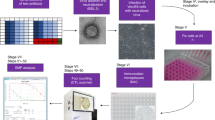Abstract
Assays that measure RSV-specific neutralizing antibody activity are very useful for evaluating vaccine candidates, performing seroprevalence studies, and detecting infection. Neutralizing antibody activity is normally measured by a plaque reduction neutralization assay or by a microneutralization assay with or without complement. These assays measure the functional capacity of serum (or other fluids) to neutralize virus infectivity in cells as compared to ELISA assays that only measure the binding capacity against an antigen. This chapter discusses important elements in standardization of the RSV-specific microneutralization assay for use in the laboratory.
Access this chapter
Tax calculation will be finalised at checkout
Purchases are for personal use only
Similar content being viewed by others
References
Mansbach JM, Piedra PA, Teach SJ, Sullivan AF, Forgey T, Clark S, Espinola JA, Camargo CA Jr (2012) Prospective, multicenter study of viral etiology and hospital length-of-stay in children with severe bronchiolitis. Arch Pediatr Adolesc Med 166:700–706
Peret TC, Hall CB, Hammond GW, Piedra PA, Storch GA, Sullender WM, Tsou C, Anderson LJ (2000) Circulation patterns of group A and B human respiratory syncytial virus genotypes in 5 communities in North America. J Infect Dis 181:1891–1896
Tapia LI, Shaw CA, Aideyan LO, Jewell AM, Dawson BC, Haq TR, Piedra PA (2014) Gene sequence variability of the three surface proteins of human respiratory syncytial virus (hRSV) in Texas. PloS One 9(3):e90786
Agenbach E, Tiemessen CT, Venter M (2005) Amino acid variation within the fusion protein of respiratory syncytial virus subtype A and B strains during annual epidemics in South Africa. Virus Genes 30:267–278
Shobugawa Y, Saito R, Sano Y, Zaraket H, Suzuki Y et al (2009) Emerging genotypes of human respiratory syncytial virus subgroup A among patients in Japan. J Clin Microbiol 47:2475–2482
Eshaghi A, Duvvuri VR, Lai R, Nadarajah JT, Li A et al (2012) Genetic variability of human respiratory syncytial virus a strains circulating in Ontario: a novel genotype with a 72 nucleotide g gene duplication. PLoS One 7:e32807
Avadhanula V, Chemaly RF, Shah DP, Ghantoji SS, Azzi JM, Aideyan LO, Mei M, Piedra PA (2015) Infection with novel respiratory syncytial virus genotype Ontario (ON1) in adult hematopoietic cell transplant recipients, Texas, 2011-2013. J Infect Dis 211(4):582–589
Trento A, Galiano M, Videla C, Carballal G, Garcia-Barreno B et al (2003) Major changes in the G protein of human respiratory syncytial virus isolates introduced by a duplication of 60 nucleotides. J Gen Virol 84:3115–3120
Trento A, Viegas M, Videla C, Carballal G, Mistchenko AS (2006) Natural history of human respiratory syncytial virus inferred from phylogenetic analysis of the attachment (G) glycoprotein with a 60-nucleotide duplication. J Virol 80:975–984
Swanson KA, Settembre EC, Shaw CA, Dey AK, Rappuoli R et al (2011) Structural basis for immunization with postfusion respiratory syncytial virus fusion F glycoprotein (RSV F) to elicit high neutralizing antibody titers. Proc Natl Acad Sci U S A 108:9619–9624
McLellan JS, Chen M, Leung S, Graepel KW, Du X et al (2013) Structure of RSV fusion glycoprotein trimer bound to a prefusion-specific neutralizing antibody. Science 340:1113–1117
Magro M, Mas V, Chappell K, Vazquez M, Cano O et al (2012) Neutralizing antibodies against the preactive form of respiratory syncytial virus fusion protein offer unique possibilities for clinical intervention. Proc Natl Acad Sci U S A 109:3089–3094
Lima HN, Botosso V, Oliveira DBL, Almeida Campos AC, Leal AL et al (2012) Molecular epidemiology of the SH (small hydrophobic) gene of human respiratory syncytial virus (HRSV), over 2 consecutive years. Virus Res 163:82–86
Schepens B, Sedeyn K, De Baets S, Schotsaert M, Roose K et al (2014) Protection and mechanism of action of a novel human respiratory syncytial virus vaccine candidate based on the extracellular domain of small hydrophobic protein. EMBO Mol Med 6(11):1436–1454
Piedra PA, Jewell AM, Cron SG, Atmar RL, Glezen WP (2003) Correlates of immunity to respiratory syncytial virus (RSV) associated-hospitalization: establishment of minimum protective threshold levels of serum neutralizing antibodies. Vaccine 21:3479–3482
Luchsinger V, Piedra PA, Ruiz M, Zunino E, Martínez MA, Machado C et al (2012) Role of neutralizing antibodies in adults with community-acquired pneumonia by respiratory syncytial virus. Clin Infect Dis 54:905–912
Glenn GM, Smith G, Fries L, Raghunandan R, Lu H, Zhou B, Thomas DN, Hickman SP, Kpamegan E, Boddapati S, Piedra PA (2013) Safety and immunogenicity of a Sf9 insect cell-derived respiratory syncytial virus fusion protein nanoparticle. Vaccine 31(3):524–532
Author information
Authors and Affiliations
Corresponding author
Editor information
Editors and Affiliations
Rights and permissions
Copyright information
© 2016 Springer Science+Business Media New York
About this protocol
Cite this protocol
Piedra, P.A., Hause, A.M., Aideyan, L. (2016). Respiratory Syncytial Virus (RSV): Neutralizing Antibody, a Correlate of Immune Protection. In: Tripp, R., Jorquera, P. (eds) Human Respiratory Syncytial Virus. Methods in Molecular Biology, vol 1442. Humana Press, New York, NY. https://doi.org/10.1007/978-1-4939-3687-8_7
Download citation
DOI: https://doi.org/10.1007/978-1-4939-3687-8_7
Published:
Publisher Name: Humana Press, New York, NY
Print ISBN: 978-1-4939-3685-4
Online ISBN: 978-1-4939-3687-8
eBook Packages: Springer Protocols




